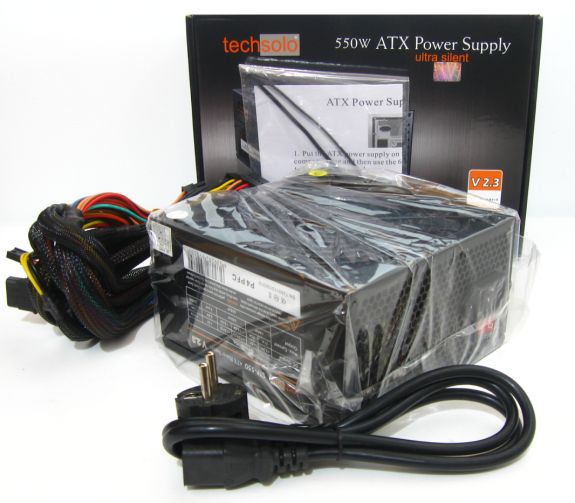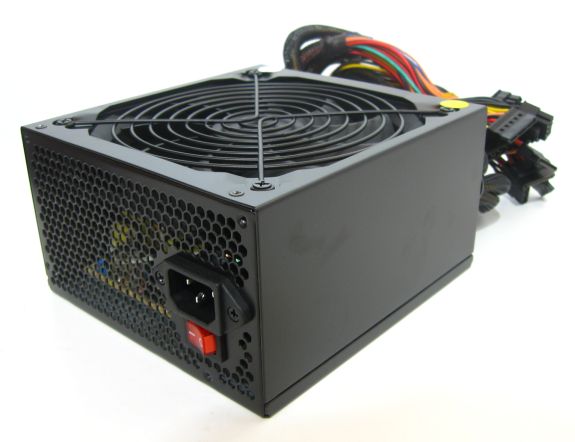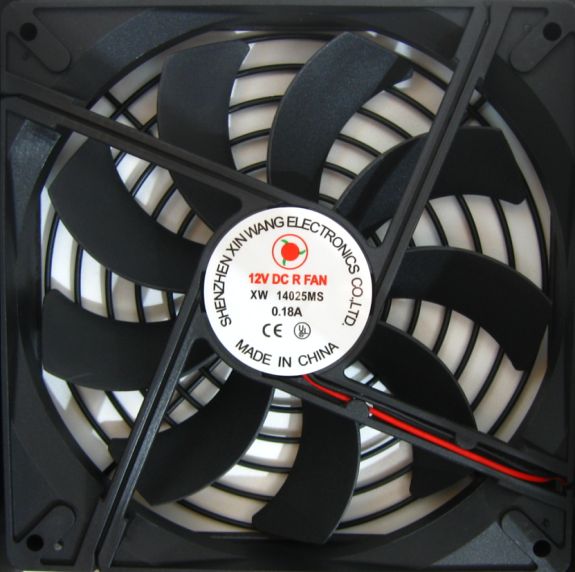550W Roundup: Three PSUs at Different Prices
by Martin Kaffei on October 28, 2010 4:00 PM ESTTechsolo Black Mamba STP-550
Techsolo keeps things simple with their packaging and extras. You get a standard power cable (for Europe), four screws, some cable ties, and a short user manual. The best-case hope for the Techsolo Black Mamba is that we'll get an "ultra silent" snake that can deliver the full rated power. I wouldn't bet on it, but more than one user has been tempted into going the cheap route on a PSU. At worst, the Black Mamba is a noisy blindworm that dies at 50% load, but most likely it will land somewhere in between those extremes.
The red (already mentioned and super-duper) power switch stands in contrast to the black case design. The fan grill and the cable sleeving are black too and the housing of the ATX 2.2-PSU is 14cm long. Considering the cost, the PSU actually looks decent—even cheap cable sleeving is a bump up over unsleeved cables, after all.
| Cables and Connectors | ||
| Fixed | Main | 24-pin 40cm |
| ATX12V/EPS12V | 4+4-pin 45cm | |
| PCIe | 6-pin 45cm | |
| Peripheral | 3x PATA 40-70cm + Floppy 15cm | |
| 3x SATA 40-70cm / 3x SATA 40-70cm | ||
The main cables are very short at less than 50cm, and there are only six SATA and three Molex power connectors along with a single PEG connector for graphic cards—the latter seems particularly skimpy. We don't want to be too quick to judge, but this is not a good configuration for a 550W PSU; it looks more like a 400W PSU. We'll get into more details on the next page.
Shenzhen Xin Wang Electronics Co., LTD. makes the fan, one of those nameless (despite the length of their name) Chinese companies. The 140mm fan needs fewer amps than the other fans in this roundup and it has nine fan blades. Will it be silent, and can it keep the PSU cool? We'll find out in a minute.













82 Comments
View All Comments
Phaedrus2129 - Friday, October 29, 2010 - link
Except many of the highest-quality units are only of moderate weight due to requiring fewer components; and some of the crappiest units are now being sold with iron weights inside to make them heavier.Weight is a very poor test, actually opening the power supply up and looking with a critical eye is a thousand times better. I would disregard entirely any reviewer who uses weight as a factor in evaluating PSU quality.
sprockkets - Friday, October 29, 2010 - link
If it is such a poor test, why not then compare the weight and find out?It isn't as poor as you want it to be for arguments sake.
Phaedrus2129 - Friday, October 29, 2010 - link
Then all the PSUs with passive power factor correction would be hailed the best because of the weight added by the massive PFC coil. Vs. APFC units with lighter, but more effective components (couple switching transistors, a small coil, shares the primary capacitor, and a controller IC, still weighs less than a PPFC coil).sprockkets - Friday, October 29, 2010 - link
Bud, it's just a simple metric. Like you know, how a standard InWin PowerMan 350w PS weighs 2 lbs 10 oz and a standard FSP 300w power supply weights 3 lbs 5 oz.Besides, I wouldn't compare a passive vs. active PFC power supply anyhow and make that mistake.
Phaedrus2129 - Saturday, October 30, 2010 - link
I can see just recording the weight for posterity's sake, but one should *not* use weight as a metric of quality or performance. All more weight indicates is more components, heavier heatsinks, thicker wiring, heavier housing. For making a split-second field judgment, sure, but it is made completely redundant by opening the power supply up to appraise components and quality.I can tell far more about a PSU's quality from a quick glance at the secondary-side rectifiers than from measuring its weight.
Stuka87 - Friday, October 29, 2010 - link
I really liked seeing the comparison of the three. I would have liked to of seen a 4th super high end PSu thrown in, but it may have been a bit redundant.As for the low end, there are certainly better supplies out there for that price. You can even get lower end Antec's (like the 430 Basiq) for the same price as the one that blew up and while its not as good as the better Antec's, its better than the chinese no-name stuff.
benedict - Friday, October 29, 2010 - link
The review is clearly biased towards the higher-end PSUs. I don't dare say the reviewer deliberately picked a very poor part just to prove his point. There are some very decent PSUs for 30-40 euro that don't blow up at 50% load. For example, the FSP Saga II achieves 80%+ efficiency, costs about 40 euro and is very silent. Please, show some real part in the value price section and not some handpicked garbage.Phaedrus2129 - Friday, October 29, 2010 - link
This unit is actually above average for "garbage" power supplies. If he were intentionally picking a terrible PSU he'd choose something from Leadman, or Sunpro, that will blow up at 250W and have ripple in the 300mV+ range on all rails.marvdmartian - Friday, October 29, 2010 - link
In almost 10 years now of building my own systems, I have only ever been 'stung' by 2 power supplies. Both of them were Antecs, which died long before they should have, and both of them took out a motherboard while they were at it.Needless to say, I'm somewhat reluctant to ever trust an Antec psu to power my systems. Fool me twice, shame on me......fool me 3 times? I don't think so!!
OCZ would get my vote in this competition, hands down.
mmatis - Friday, October 29, 2010 - link
Especially since NewEgg is offering it with a $15 MIR through 31 October. It has 433 reviews on their site and gets 5 eggs.